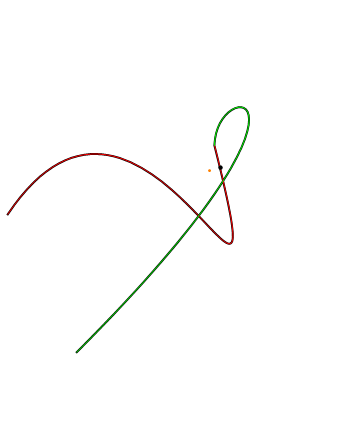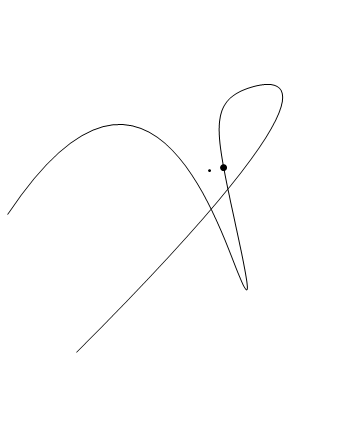Simply using BezierFunction is not enough. The BezierFunction will not match the BezierCurve because that curve is actually a composite of multiple splines - see here: BezierCurve is different from BezierFunction.
This below is adapted from the above and @J. M.'s technical difficulties solution:
You need to first chop your spline into its components and minimize over both, then find which closest point on each sub-spline is closer to your point. See here on how to produce the parts: How to construct BezierFunction for BezierCurve with npts>4 and SplineDegree -> 3?
pt = {-0.07194, 0.6342}; pts = {{-3, 0}, {-1, 3}, {1, -3}, {0, 1}, {0, 2}, {2, 2}, {-2, -2}}; bzsplinefns = BezierFunction /@ Partition[pts, 4, 3]; distance[p1_, p2_] := SquaredEuclideanDistance[p1, p2] splineDistance[spline_, point_, t_?NumericQ] := distance[spline[t], point] closest[spline_, point_] := NArgMin[{splineDistance[spline, point, t], 0 < t < 1}, t] tvals = closest[#, pt] & /@ bzsplinefns; finalNearestPoint = MinimalBy[MapThread[#1[#2] &, {bzsplinefns, tvals}], distance[#, pt] &][[1]] Graphics[{Point[pt], Thick, Gray, BezierCurve[pts], Thin, {RandomColor[], Line[Table[#[t], {t, 0, 1, 0.01}]]} & /@ bzsplinefns, PointSize[Large], Point[finalNearestPoint]}] If you choose BSplineCurve instead, you don't need to worry about breaking it into multiple BSplineFunctions - you can just minimize a single BSplineFunction that accounts for the whole curve.
pt = {-0.07194, 0.6342}; pts = {{-3, 0}, {-1, 3}, {1, -3}, {0, 1}, {0, 2}, {2, 2}, {-2, -2}}; distance[p1_, p2_] := SquaredEuclideanDistance[p1, p2] splineDistance[spline_, point_, t_?NumericQ] := distance[spline[t], point] closest[spline_, point_] := NArgMin[{splineDistance[spline, point, t], 0 < t < 1}, t] bsp = BSplineFunction[pts]; result = bsp[closest[bsp, pt]] Graphics[{BSplineCurve[pts], Point[pt], PointSize[Large], Point[result]}] 

